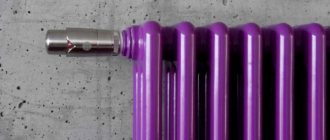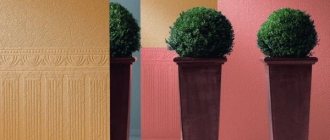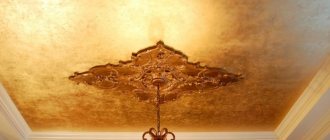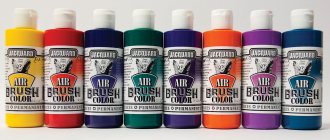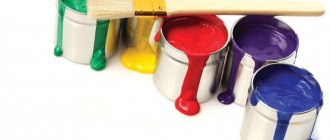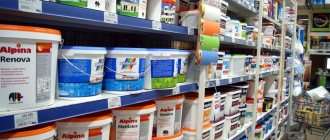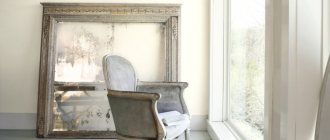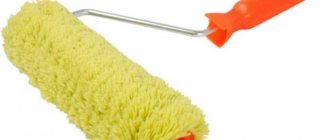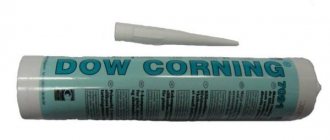With the beginning of the widespread introduction of plastic as a material for the manufacture of pipes, steel has somewhat lost its position, but metal pipes still remain in demand.
Painting heating pipes
There are several reasons for this:
- Strength of steel pipes. Thanks to this quality, they are unrivaled for use in high-pressure pipelines. This property allows the use of pipes with a wall several times thinner than that of plastic pipes.
- Low coefficient of thermal expansion. Due to this, when heated, a steel pipe has a linear expansion that is 15-20 times less than polyethylene pipes.
- Ability to provide 100% tightness. Therefore, steel pipes have no alternative when used in closed engineering systems.
The main disadvantage is their vulnerability to iron corrosion. Without protection against iron corrosion, pipes have a service life of no more than 10 years, and their performance begins to noticeably decline after two to three years of operation.
Painting a square metal pipe
To protect iron from corrosion, various methods are used, the most common of which is coating the surface of pipes with anti-corrosion paint. But the use of such paints requires the complete absence of rust on the surface being treated.
The problem is that steel begins to corrode iron from the moment it is made, which is why the surface of the pipes must be thoroughly cleaned before painting. Processing is a labor-intensive and costly process; often such processing is simply impossible due to the inaccessibility of the required area.
The problem is solved by using paints that can be applied to metal over rust.
Types of paints for metal surfaces
Paints used for application to metal surfaces are divided into the following types:
- Oil paints consisting of natural oils. They are sensitive to temperature changes, so they are used for painting indoor pipes. They provide some protection against corrosion, but its degree is low and the protection does not last very long.
- Epoxy enamels that contain toxic resins. They are mainly used to protect industrial pipelines. But their main purpose is to provide protection from high-temperature influences; they protect against corrosion only slightly better than oil paint.
- The main area of application of alkyd paints is painting galvanized steel surfaces. They are characterized by a high degree of adhesion to the working surface, but at the same time, they cannot withstand high temperatures and easily catch fire.
- Of all the above types of paints, acrylic paints provide the best anti-corrosion protection. Due to their immunity to temperature fluctuations, they can be used for both indoor and outdoor use.
Metal paint
Important! Before painting, you should make sure that it corresponds to the temperature conditions in which the painted product is expected to be used.
Principle of choosing paint for pipes
Before we talk about how to properly paint heating pipes, it is necessary to determine the criteria for choosing the right composition suitable for such work.
In this case, it is important to consider the following requirements for the coloring composition:
- the material must withstand high temperatures (from 100°C and above);
- another important property that the composition must have is wear resistance;
- the toxicity of the painting mixture should be minimal;
- the paint must be resistant to aggressive environments.
Features of paints for working on rust
In order for rust paint to provide maximum anti-corrosion protection, manufacturers use a combined approach, trying to combine the properties of conventional paints with the properties of a protective primer and a rust converter.
Because of this, the range of such paints is very diverse and every day it is replenished with new names. The same can be said about their recipe.
Rust paints can be very roughly classified according to the following criteria:
- What main type of paint are they based on?
- For what purposes are they intended?
- What temperature conditions are they designed for?
- What are the main components included in their composition?
Painting a metal pipe
It is not surprising that it is not easy to classify rust paint as a specific type. Each description represents a combination of different performance characteristics.
This can be illustrated using the example of one of the most popular groups of dyes – hammer dyes.
Calculation of the required amount of paint
Before painting the pipes, it is necessary to calculate the amount of paint. On the packaging, manufacturers indicate the approximate consumption per square meter of surface when applying one layer. It is easy to calculate the surface area of a pipe by remembering a simple mathematical formula. The surface area of the pipe will be equal to its length multiplied by the diameter and by the number Pi. Be sure to take into account that the paint will be applied in two layers and thus the required amount can be easily calculated.
Hammer paint for rust
Hammer paint owes its name to the appearance of the finish it creates. It looks like it was hammered with a small hammer. This effect is achieved due to the fact that it contains aluminum and silicone components.
Any hammer paint has increased adhesion, that is, hammer paint provides high-quality adhesion to the surface being painted. Therefore, painting can be done over rust.
Important! Hammer paint cannot be applied to surfaces that have flaking rust. In this case, preliminary cleaning is necessary before painting.
Typically, hammer paint is produced in the form of a suspension of anti-corrosion metal pigments and fillers in synthetic resins or varnishes, supplemented with silicone and other components.
Thanks to pigments, it is available in a wide range of colors: black, blue, yellow and so on. But the most popular are black and brown paint, since painting with them gives the maximum decorative effect.
Functionally, hammer paint acts as a primer, as an anti-corrosion protection, as a rust converter due to inhibitors, and as a decorative enamel, which provides additional protection.
Hammer paint for rust
Therefore, it is not necessary to apply a separate primer before painting.
Hammer enamel is used for painting not only steel, but also galvanized surfaces. In addition, it can be used for painting surfaces made of non-ferrous metals.
Before use, the enamel is mixed to obtain a homogeneous mass.
The working surface is cleaned with a stiff brush and degreased.
- The first layer of enamel acts as a primer.
- The second layer, due to the silicone elements that the enamel contains, enhances the anti-corrosion effect, preventing the infiltration of moisture microparticles through the protective layer, resulting in the creation of a waterproof film.
- The third layer acts like hammer enamel, creating a decorative effect and at the same time being another barrier to corrosion.
Thus, a line of triple protection against iron corrosion is created, waterproof and sufficiently resistant to mechanical stress.
Important! Hammer paint is not heat resistant. As a rule, its operation is allowed at temperatures not exceeding 150 degrees.
How to paint pipes
Typically, heating pipes are painted every five to seven years, that is, quite rarely. It is advisable to apply paint after other types of repairs have already been completed. Before painting, carefully protect the walls and floors from accidental splashes; Even if you are a skilled craftsman, you still won’t be able to completely get rid of drops of paint.
Don't forget to clean the battery before painting
The color of the paint has a big impact on the ability of the pipes to transfer heat. Experts recommend not white, which is preferred by most owners, but black or another dark color. Another thing is that this color often does not harmonize with the overall style of the room or simply seems “gloomy”. Here the owner should think about what is more important to him – design or practicality. You can, of course, choose a compromise option (dark gray metallic pipes) or work out the appearance of the room so that the dark pipes and radiator fit into it.
The primer is applied in a thin layer, after which paint is applied using a roller or spray can. A total of two layers of paint are needed, each of which should dry for about six hours. After painting is completed, you should wait a certain period before starting to use the pipes.
step-by-step instructions for cleaning the battery
In principle, you can paint with regular enamel, but experts recommend preferring alkyd because of a number of advantages (dries quickly, easy to apply).
When painting, it is recommended to use cans and sprayers rather than traditional methods. The only exceptions are some cases (for example, painting a radiator).
Painting a cast iron radiator
This part of the process is one of the most difficult. The radiator should not be painted over the old layer, because the surface will be uneven and rough. Since the radiator is often located in a place that is inconvenient for maintenance, it is recommended to remove it before painting. To treat the radiator, it is advisable to use a foam roller of small diameter, which can paint smoothly and penetrate into the most difficult places.
Step-by-step instructions for painting batteries
Hot or cold?
People often ask whether it is possible to paint pipes “hot”. It is not recommended to do this, since in this case spots and stains will appear on the surface, and the paint will lie unevenly. So it is necessary to paint when the heating season has not yet begun.
what paint to paint hot batteries
Aerosol paint for metal
Aerosol paint for metal against rust comes in three types:
- Standard, used for simple one-layer painting.
- Double, which acts as primer and enamel. Its advantage is that before painting the surface there is no need to apply a separate primer to it.
- A universal aerosol paint that simultaneously acts as a primer, regular enamel and a rust converter.
Aerosol paint for metal
To work on rust, type 3 aerosol paint is used. One can of it is enough to apply to a surface of approximately 3.5 m2, with a layer 0.05 mm thick. Therefore, spray paint on metal is not used over large areas. It is advisable to use it for small surface areas.
Aerosol paint for metal and rust is especially convenient for touching up damaged paint layers and for painting hard-to-reach places.
As a rule, aerosol paint for metal against rust is multifunctional; in addition to working on steel surfaces, it is suitable for painting non-ferrous metals, as well as wood, plaster and stone.
Under what conditions can metals be painted without stripping?
A typical pre-treatment process for metal surfaces consists of stripping, passivation (primer with a special composition) and painting. Usually, rust is removed to the “living” layer, but when carrying out large-scale or specific work, this is not always acceptable (for example, when painting a ceiling or bathroom).
There are two main criteria that determine whether it is possible to paint over rust, or more precisely, whether it will be more rational from a technological and economic point of view:
- Degree of damage. This includes the thickness of the rusty layer, as well as the density of the scale and the strength of its adhesion to the main surface;
- Form of plaque formation. Uniform distribution and dust-like structure provide sufficient conditions for reliable adhesion of the paint and varnish coating to the base and the formation of a protective barrier. Porosity, the loose nature of rust, the presence of scale and delamination determine the need for additional mechanical cleaning, as well as the use of special products.
Properties of aerosol against rust
Spray paint creates a durable finish. The waterproof protection it creates serves as a reliable barrier against atmospheric moisture and temperature changes. It also plays a protective role against moderate chemical exposure. Therefore, it can be used for both domestic and industrial facilities.
During operation, it shows high physical stability, so the coating formed by it is quite elastic, does not delaminate or crack.
Usually on aerosol cans it is written that it is heat-resistant. But it must be remembered that it contains rust converters, which are vulnerable to high temperature exposure. Therefore, the painted coating is intended for use at temperatures not exceeding 150 degrees.
If it is expected that the product to be painted will operate in an environment with a higher temperature, a special heat-resistant aerosol of the second type is used. It is worth mentioning that before painting with such an aerosol, primer must be applied to the working surface.
The first layer dries to a non-sticky state in a quarter of an hour, its complete drying occurs in half an hour.
Rust paint
The second layer can be applied two hours after the first layer has dried.
Types of paint for heating pipes
When deciding what paint to paint heating pipes with, you should pay attention to the following types of compositions, which are most popular among consumers today:
- acrylic enamels
. This paint is based on organic solvents, which explains the not entirely pleasant smell when it dries. However, such a sample will provide a perfectly smooth and glossy surface and will last a very long time; - alkyd type enamels
. These compounds also emit an unpleasant odor, which may periodically appear in the future when the heating system is actively working. However, such paint will be very resistant to any mechanical damage and will not change its structure under the influence of high temperature. Do not forget that on the modern market there is a wide selection of shades of such enamel, so choosing an option suitable for a particular interior will not be difficult; you will only need to study the photos of samples provided by the manufacturer; - water-dispersion based paints
. Painting heating pipes with this composition is the most common option among consumers. This composition does not emit an unpleasant odor; in addition, this paint for hot heating pipes dries very quickly.
It is also impossible not to mention such an option as oil paint, which, however, is used extremely rarely today for painting pipes.
What and how to paint heating pipes is, of course, up to the consumer himself, however, in order for such work to go smoothly and without any difficulties, one should pay attention to a number of recommendations regarding surface preparation procedures before painting.
Preparing the work surface
- Surface treatment for aerosol painting is carried out in the same way as for rust enamel in the form of a suspension.
- The surface is cleaned with a stiff brush to remove dirt deposits, loose rust and old paint residues.
- Then it is degreased using gasoline or acetone.
- After this, the surface is washed with soapy water and dried.
Cleaning pipes from rust
How to paint pipes correctly
The main reason for painting pipes is to protect them from corrosion. Unfortunately, since the 50s of the 20th century, in order to save money, they began to install steel pipes for heating, as well as for cold and hot water. These pipes, of course, were not coated with anti-corrosion protective agents and were very vulnerable to rust formation. And when, in the 80-90s, the installation of engineering structures practically ceased to be controlled by construction organizations due to strict financial conditions, it became possible to use cheap steel pipes (which were essentially intended to carry gas) in heating and plumbing systems.
As a result, after ten years of their use without touch-up, they begin to crumble. Unfortunately, water pipes made of steel are still often used in apartments, although galvanized or plastic pipes do not require any corrosion protection at all. However, it must be taken into account that the protective coating on the threads of galvanized pipes is often damaged and in this case it is better to tint the threads.
Preparing pipes for painting
Wet pipes cannot be painted - but often those carrying cold water are much colder than the air in the room and for this reason so-called condensation forms on their surface.
To dry cold water pipes, it is enough to turn off the water supply in the apartment for a day, making the necessary reserve in advance. The temperature will become equal to the room temperature and the moisture will evaporate.
In the case of painting the riser, you will have to use a fan, with a strong directing air flow from which the moisture will evaporate a little faster and there will be no condensation on it.
About coloring
Before you start painting the pipes, you need to remove layers of rust or old paint, which can be easily removed using a sharp knife. If it is difficult to remove old paint, you can use a hair dryer, heat it up and then clean it well. The main thing is not to overheat the threaded connections, so that the winding does not burn out and the pipes do not leak.
After cleaning with a knife, the pipes should be cleaned with a metal brush to remove any remaining rust and old paint, thus preparing them for priming. The MT 2003 magnetic thickness gauge will help you check whether paint remains on the pipes and carry out cleaning more efficiently.
It is best to prime them using an anti-corrosion primer to protect against rust and for better paint coverage. When it is completely dry, they begin to paint the pipes. It is best to use thin two layers of paint. When the paint thickens, it is necessary to dilute it, otherwise the thick paint will leave unsightly streaks, and it will take much longer to dry.
Mode of application
When using an aerosol, you must shake the can periodically. An indicator of its readiness for use is the free movement of balls inside it, which serve to mix the composition.
When spraying, the can should be held in a vertical position, evenly making back-and-forth movements. The work is carried out from a distance of 20 cm.
The use of aerosols is possible in a temperature range from +5 to +32 degrees Celsius.
If necessary, remove paint; fresh paint can be removed with acetone, and dried paint can be removed with a special remover.
Painting
Before painting, it is recommended to protect the floor under the pipes with film or newspapers. We start painting from the top of the pipes and move towards the bottom. This way the layer will be even. We apply the first layer of paint to the entire surface - do not miss anything. Only after applying the first layer to the entire surface can the second be applied. Applying two layers allows you to get a perfectly painted, smooth surface.
How to quickly paint pipes? To save time, you can use a spray can or spray gun. In addition to saving time, this will give us a high-quality painted, smooth surface. When working with a spray can, you need to hold it at a distance of 30 cm from the surface and make zigzag movements from top to bottom. When using a spray gun to paint the battery, it is recommended to remove it in order to properly treat all hard-to-reach places.
After painting, you need to wait a certain time for the paint to dry and thoroughly ventilate the room.
Rules for painting outside and inside the apartment
GOST 14202-69 defines exactly what color and with what identification marks a pipeline for any purpose should be painted. Thus, both the team arriving for repairs and people living nearby can immediately determine which communications have been damaged and what danger they pose.
Gas pipes are designed to transmit different gases and are marked accordingly:
- the natural gas pipeline is painted yellow without additional rings;
- pipes for acetylene transmission are painted white;
- oxygen supply products are blue;
- compressed air is indicated in deep blue;
- carbon dioxide transfer is indicated in orange.
Painting of a gas pipe running along the facade of a building and on the street is rarely done along its entire length. Firstly, the highways are too long, and secondly, multi-colored segments spoil the appearance of the facade. As a rule, individual areas are painted in order to designate the system.
It is recommended to paint metal gas ducts on the façade of a building in colors that reduce the thermal effect of sunlight.
Identification staining is used in certain areas: at junctions during branching. Painting gas pipes on the facade of a house that pass through a wall must include an appropriate color marker. Painting a pipe passing through a wall.
Inside a building or home, gas pipes are painted in accordance with the requirements of the interior. As a rule, the basic coloring of linear meters of a gas pipeline is white. A gas pipe passing through a wall is not specially marked. Painting services are provided by the builders themselves.
Pipe cleaning stage
The surface of the highway is cleared of old CM in two ways:
- After the sandblasting method, the surface structure changes and roughness appears. Contaminants, old paint, and traces of corrosion in the oil pipeline, water and gas supply pipes are removed. Communications made of plastic and PVC under powerful pressure of the substance become clean and undamaged. The abrasive component works in tandem with compressed air. The rough surface enhances the adhesion of the pipeline to the CM. The sandblasting method is the answer to the question of how to clean paint from a pipe in hard-to-reach places. The treated surface is completely ready for painting. A mobile device is used, which supplies a strong flow to the pipes.
- The surface structure does not change after gentle hydro-jet cleaning. A special apparatus supplies water supplied by high-pressure pumps. Old paint, varnish, grease, and traces of rust are removed from the surface. The disadvantage of this method is that it is impossible to carry out cleaning in frosty conditions; the water freezes.
Gas pipeline painting
For a branch transporting gas, it is important to be protected from corrosion. Therefore, paint for the gas line is purchased with a reserve. Saving in this case is dangerous.
On the street, any external compounds are used that protect against corrosion:
- the classic version is PF-115 alkyd enamel. Enamel PF-115 `VITEko` 1.8 kg. Yellow, price 174 rubles. Alkyd enamel resists weather conditions. A dense protective layer is formed with a service life of at least 5 years, another plus is the low price;
- polyurethane dye is in demand due to its high adhesion to the pipe and elasticity. The coating effectively serves for 10-12 years. Polyurethol (UV) - ultra-strong two-component polyurethane primer-enamel 3 in 1 for rust, price 34 rubles / m 2;
- epoxy two-component paint Epostat is characterized by resistance to wear, but the elasticity of the coating is less than that of polyurethane.
- The electrically conductive substance covers communications for many years and has high anti-corrosion properties.
Important: it is prohibited to remove the old paint layer from the gas pipeline using heating devices. Otherwise, the branch transporting gas is painted, like any metal pipe.
Inside a private household, the color of communications is not regulated. It can be close to the color of the interior. But according to technical characteristics, the coating cannot be vapor-permeable. Otherwise, the surface will not be insulated from oxygen and moisture.
Whatever paint is used to paint gas communications, the processing process is divided into stages:
- the area that is being prepared for painting is wrapped in a cloth soaked with a remover;
- after 20 minutes, the fabric is removed and the old layer of CM is removed with a spatula;
- traces of rust are removed with a metal brush before degreasing the pipe before painting;
- a degreaser is applied;
- the primer is applied in 2 layers;
- The CM is covered with a thick layer. A roller for painting gas pipeline pipes is not recommended. It is more convenient to work with a small brush.
